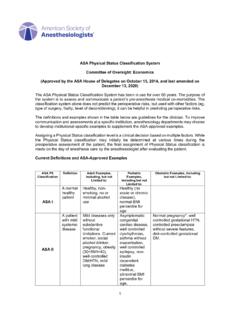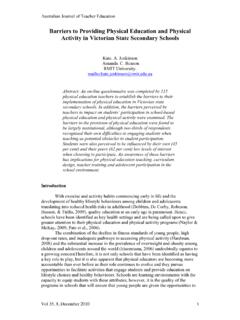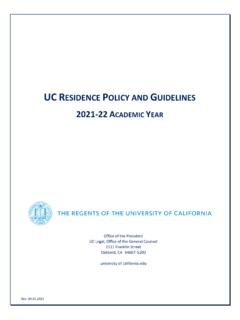Transcription of ICF Checklist revSep2003 - WHO
1 ICF Checklist world health organization , September 1 ICF CHECKLISTV ersion , Clinician Form for International classification of Functioning, Disability and HealthThis is a Checklist of major categories of the International classification of Functioning, Disability and health (ICF)of the world health organization . The ICF Checklist is a practical tool to elicit and record information on thefunctioning and disability of an individual. This information can be summarized for case records (for example, inclinical practice or social work). The Checklist should be used along with the ICF or ICF Pocket 1.
2 When completing this Checklist , use all information available. Please check those used: [1] written records [2] primary respondent[3] other informants [4] direct observationIf medical and diagnostic information is not available it is suggested to completeappendix 1: Brief health Information (p 9-10) which can be completed by the 2. Date __ __ /__ __/ __ __ H 3. Case ID _ _ , __ __ __ , __ H 4. Participant No. __ __ , __ __ , __ __ __Day Month Year CE or CS Case No. 1st or 2nd Evalu FTCSite NAME (optional)First _____ SEX (1) [ ] Female(2) [ ] DATE OF BIRTH _ _/_ _/_ _(date/month/year) ADDRESS (optional) YEARS OF FORMAL EDUCATION _ CURRENT MARITAL STATUS.
3 (Check only one that is most applicable)(1) Never married[ ] (4) Divorced[ ](2) Currently Married[ ] (5) Widowed[ ](3) Separated[ ] (6) Cohabiting[ ] CURRENT OCCUPATION (Select the single best option)(1) Paid employment [ ] (6) Retired[ ](2) Self-employed [ ](7) Unemployed ( health reason)[ ](3) Non-paid work, such as volunteer/charity[ ] (8) Unemployed (other reason)[ ] (4) Student[ ](9) Other[ ](5) Keeping house/House-maker[ ] (please specify) MEDICAL DIAGNOSIS of existing Main health Conditions, if possible give ICD No Medical Condition exists2.. ICD code: __.
4 __. __3.. ICD code: __. __. __4.. ICD code: __. __. __5. A health Condition (disease, disorder, injury ) exists, however its nature or diagnosis is not knownPART 1a: IMPAIRMENTS of BODY FUNCTIONS Body functions are the physiological functions of body systems (including psychological functions). Impairments are problems in body function as a significant deviation or Qualifier: Extent of impairments0 No impairment means the person has no problem1 Mild impairment means a problem that is present less than 25% of the time, with an intensity a person can tolerateand which happens rarely over the last 30 Moderate impairment means that a problem that is present less than 50% of the time, with an intensity, which isinterfering in the persons day to day life and which happens occasionally over the last 30 Severe impairment means that a problem that is present more than 50% of the time, with an intensity.
5 Which ispartially disrupting the persons day to day life and which happens frequently over the last 30 Complete impairment means that a problem that is present more than 95% of the time, with an intensity, which istotally disrupting the persons day to day life and which happens every day over the last 30 Not specified means there is insufficient information to specify the severity of the Not applicable means it is inappropriate to apply a particular code ( b650 Menstruation functions for woman inpre-menarche or post-menopause age). Short List of Body FunctionsQualifierb1. MENTAL FUNCTIONS b110 Consciousness b114 Orientation (time, place, person) b117 Intellectual ( incl.)
6 Retardation, dementia) b130 Energy and drive functions b134 Sleep b140 Attention b144 Memory b152 Emotional functions b156 Perceptual functions b164 Higher level cognitive functions b167 Languageb2. SENSORY FUNCTIONS AND PAIN b210 Seeing b230 Hearing b235 Vestibular (incl. Balance functions) b280 Painb3. VOICE AND SPEECH FUNCTIONS b310 Voiceb4. FUNCTIONS OF THE CARDIOVASCULAR, HAEMATOLOGICAL, IMMUNOLOGICAL AND RESPIRATORY SYSTEMS b410 Heart b420 Blood pressure b430 Haematological (blood) b435 Immunological (allergies, hypersensitivity) b440 Respiration (breathing)b5.
7 FUNCTIONS OF THE DIGESTIVE, METABOLIC AND ENDOCRINE SYSTEMS b515 Digestive b525 Defecation b530 Weight maintenance b555 Endocrine glands (hormonal changes)b6. GENITOURINARY AND REPRODUCTIVE FUNCTIONS b620 Urination functionsICF Checklist world health organization , September 3 b640 Sexual functionsb7. NEUROMUSCULOSKELETAL AND MOVEMENT RELATED FUNCTIONS b710 Mobility of joint b730 Muscle power b735 Muscle tone b765 Involuntary movementsb8. FUNCTIONS OF THE SKIN AND RELATED STRUCTURESANY OTHER BODY FUNCTIONSPart 1 b: IMPAIRMENTS of BODY STRUCTURES Body structures are anatomical parts of the body such as organs, limbs and their components.
8 Impairments are problems in structure as a significant deviation or Qualifier:Extent of impairmentSecond Qualifier: Nature of the change0 No impairment means the person has no problem1 Mild impairment means a problem that is present less than 25%of the time, with an intensity a person can tolerate and whichhappens rarely over the last 30 Moderate impairment means that a problem that is present lessthan 50% of the time, with an intensity, which is interfering in thepersons day to day life and which happens occasionally over thelast 30 Severe impairment means that a problem that is present morethan 50% of the time, with an intensity.
9 Which is partiallydisrupting the persons day to day life and which happens frequentlyover the last 30 Complete impairment means that a problem that is present morethan 95% of the time, with an intensity, which is totally disruptingthe persons day to day life and which happens every day over thelast 30 Not specified means there is insufficient information to specifythe severity of the Not applicable means it is inappropriate to apply a particularcode ( b650 Menstruation functions for woman in pre-menarcheor post-menopause age).0 No change in structure1 Total absence2 Partial absence3 Additional part4 Aberrant dimensions5 Discontinuity6 Deviating position7 Qualitative changes in structure, includingaccumulation of fluid8 Not specified9 Not applicableShort List of Body StructuresFirst Qualifier:Extent of impairmentSecond Qualifier:Nature of the changes1.
10 STRUCTURE OF THE NERVOUS SYSTEM s110 Brain s120 Spinal cord and peripheral nervess2. THE EYE, EAR AND RELATED STRUCTURESs3. STRUCTURES INVOLVED IN VOICE AND SPEECHs4. STRUCTURE OF THE CARDIOVASCULAR, IMMUNOLOGICAL AND RESPIRATORY SYSTEMS s410 Cardiovascular system s430 Respiratory systems5. STRUCTURES RELATED TO THE DIGESTIVE, METABOLISM AND ENDOCRINE SYSTEMSs6. STRUCTURE RELATED TO GENITOURINARY ANDREPRODUCTIVE SYSTEM s610 Urinary system s630 Reproductive systems7. STRUCTURE RELATED TO MOVEMENT s710 Head and neck region s720 Shoulder region s730 Upper extremity (arm, hand) s740 Pelvis s750 Lower extremity (leg, foot) s760 Trunks8.














